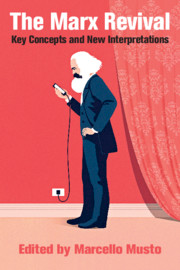Book contents
- The Marx Revival
- The Marx Revival
- Copyright page
- Contents
- About the Editor
- Contributors
- Preface
- Acknowledgements
- Note on the Text
- 1 Capitalism
- 2 Communism
- 3 Democracy
- 4 Proletariat
- 5 Class Struggle
- 6 Political Organization
- 7 Revolution
- 8 Work
- 9 Capital and Temporality
- 10 Ecology
- 11 Gender Equality
- 12 Nationalism and Ethnicity
- 13 Migration
- 14 Colonialism
- 15 State
- 16 Globalization
- 17 War and International Relations
- 18 Religion
- 19 Education
- 20 Art
- 21 Technology and Science
- 22 Marxisms
- Index
- References
10 - Ecology
Published online by Cambridge University Press: 29 May 2020
- The Marx Revival
- The Marx Revival
- Copyright page
- Contents
- About the Editor
- Contributors
- Preface
- Acknowledgements
- Note on the Text
- 1 Capitalism
- 2 Communism
- 3 Democracy
- 4 Proletariat
- 5 Class Struggle
- 6 Political Organization
- 7 Revolution
- 8 Work
- 9 Capital and Temporality
- 10 Ecology
- 11 Gender Equality
- 12 Nationalism and Ethnicity
- 13 Migration
- 14 Colonialism
- 15 State
- 16 Globalization
- 17 War and International Relations
- 18 Religion
- 19 Education
- 20 Art
- 21 Technology and Science
- 22 Marxisms
- Index
- References
Summary
The widespread recognition of Karl Marx as a leading, classical contributor to ecological thought is a fairly recent historical occurrence. The revival of Marx’s ecology since the 1960s, and especially since the 1990s, occurred in a number of stages. The dominant interpretation on the left up through the 1980s faulted Marx for his supposedly instrumentalist, ‘Promethean’, conception of nature and alleged lack of an ecological sensibility. This view resulted in what has come to be known as ‘first-stage ecosocialism’, characterized by the grafting of Green thought onto Marxism (or in some cases Marxism onto Green thought) based on the presumption that Marx’s entire critique was ecologically flawed.
- Type
- Chapter
- Information
- The Marx RevivalKey Concepts and New Critical Interpretations, pp. 177 - 196Publisher: Cambridge University PressPrint publication year: 2020
References
- 2
- Cited by

